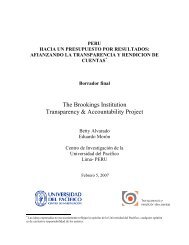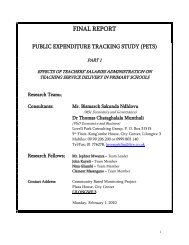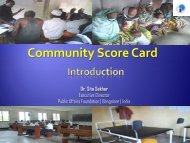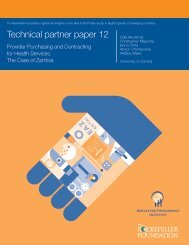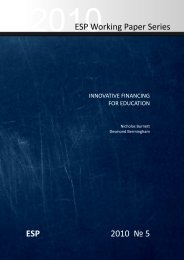Innovative Secondary Education For Skills Enhancement
Innovative Secondary Education For Skills Enhancement
Innovative Secondary Education For Skills Enhancement
You also want an ePaper? Increase the reach of your titles
YUMPU automatically turns print PDFs into web optimized ePapers that Google loves.
Section 2: What <strong>Skills</strong> Do Students Currently<br />
Acquire<br />
<strong>Secondary</strong> education suffers from being thought of as<br />
a route to higher education rather than itself being a<br />
terminal stage in education. Yet secondary education is<br />
increasingly the level from which youth enter the labor<br />
force, as secondary enrollments increase in the wake of<br />
massive enrollment advances at the primary level. As<br />
secondary education moves from an elite to a mass sector,<br />
therefore, a major rethink is needed of the skills acquired<br />
at this level.<br />
Students acquire skills in school and outside school. In<br />
secondary school they acquire both general academic and,<br />
for some, vocational skills. With exceptions, vocational<br />
education has been relatively neglected compared with<br />
academic secondary education. There are some good<br />
reasons for this, such as the relative returns reported in<br />
the “Introduction” and the high unit costs. But this relative<br />
neglect does not make sense in the face of specific skills<br />
shortages. The problem has not been the existence of vocational<br />
education but rather that it has not been targeted<br />
toward specific short-term skills needs and that it has not<br />
been practical enough. To exaggerate only very slightly,<br />
there is not a strong argument for the current norm of<br />
general TVET, which is more expensive per student than<br />
general academic secondary education. There is, however,<br />
a very strong argument for practically oriented TVET<br />
aimed at specific skill shortages. <strong>For</strong> example, Cummins<br />
(which employs about 44,000 workers around the world)<br />
has recognized the challenges that arise from the lack of<br />
coordination between TVET institutions and industry, and<br />
notes that vocational systems do not meet the market’s<br />
needs and do not incorporate the much needed “soft<br />
skills.” To counter this, Cummins is working with a trade<br />
school near its plant in India to incorporate new, relevant<br />
courses in both technical areas as well as in soft skills<br />
(Cummins 2012).<br />
This report does not go into basic cognitive skills, but we<br />
know from much other work, such as that carried out by<br />
ASER in India and Uwezo in Africa and summarized for<br />
the Global Compact on Learning (Brookings Institution<br />
2011), that there are very, very serious problems with<br />
basic skills acquisition at the primary level throughout<br />
Africa and South Asia. These problems are slightly less<br />
pronounced at the secondary level due to the selectivity<br />
currently exercised in permitting students to make the<br />
transition from primary to secondary school. Even at the<br />
secondary level, however, international comparisons—<br />
such as the Program for International Student Assessment<br />
and Trends in International Mathematics and Science<br />
Study—indicate that low-income countries generally<br />
fall far behind OECD and middle-income ones in terms<br />
of learning. Even by countries’ own standards, there are<br />
problems at the secondary level. In Nigeria, for example,<br />
90 percent of students failed the recent secondary-schoolleaving<br />
exams. As countries increase their secondary<br />
education enrollments, the continuing problems at the primary<br />
level are likely to further affect secondary education.<br />
Africa 11<br />
The secondary curricula in the four African study countries<br />
of Benin, Ghana, Kenya, and Senegal emphasize<br />
cognitive skills (literacy, numeracy, scientific literacy),<br />
some non-cognitive skills (creativity, persistence, reliability,<br />
communication), and specific technological or technical<br />
skills. Central and Southern African countries have not<br />
been included thus far in the ISESE project.<br />
With some slight variations, the skills acquired by African<br />
youth appear to be the same in both West and East Africa.<br />
The education systems, both general and vocational, are<br />
undergoing reform in many countries, which makes for<br />
some differences between skills students currently have<br />
and those that future students will likely have. Behind<br />
some of these reforms are two themes—reducing the total<br />
load of a curriculum that has grown too heavy in many<br />
countries (notably Kenya) and trying to orient learning<br />
more toward employment (notably Ghana).<br />
The most important of these reforms are in vocational<br />
education. TVET curricula have traditionally been driven<br />
more by academic progression than by future employment.<br />
Current reforms are designed to do two things:<br />
include some compulsory core skills and make them more<br />
practical. This move was aided by the ADEA 2008 Biennial,<br />
which highlighted the need for a move away from<br />
traditional TVET to a broader concept of technical and<br />
vocational skills development that is more responsive to<br />
market demand. In Ghana, for example, TVET curricula<br />
now insist also on compulsory English, mathematics,<br />
social studies, and integrated science. In Mali, Senegal,<br />
and Togo, for example, TVET courses are being restruc-<br />
11 This section is based on Anarfi and Appiah (2012).<br />
20 <strong>Innovative</strong> <strong>Secondary</strong> <strong>Education</strong> <strong>For</strong> <strong>Skills</strong> <strong>Enhancement</strong> (ISESE)







